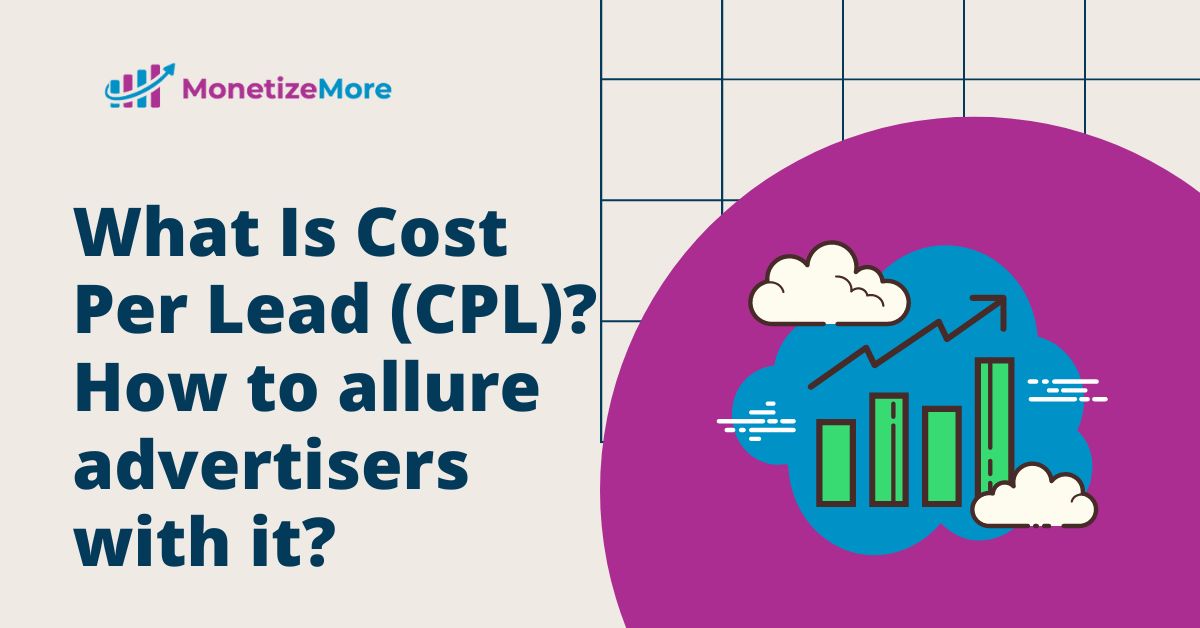
This post was most recently updated on January 18th, 2023
CPL or Cost per lead is typically used to gauge the effectiveness of your monthly marketing campaigns that is not sold on a CPC (cost per click) or CPM (cost per mille) basis. The average cost per lead by Industry varies from $30 to $165 (Source: Hubspot)
When compared with other marketing metrics, cost per lead (CPL) is a great indicator of campaign success because it is easy to calculate and can be applied to any online advertising campaign.
In this article, we’ll be talking about CPL, why it’s vital to track this metric, and the advantages it offers.
Cost per lead is the amount of money spent on marketing to generate leads, or prospective customers. The lead is acquired through online ad conversions, web page content engagement, popups, etc.
Once the user engages or clicks on the campaign, they are asked to sign up to the company’s newsletter, service, etc.
When it comes to e-commerce and revenue generation, many publishers struggle with knowing exactly how effective their marketing campaigns are — particularly from an ROI perspective.
This is the reason that so many publishers get frustrated, wondering why their revenue isn’t increasing at the rate they think it should. CPL gives you a more solid understanding of your costs and how much you spend on each customer acquisition.

CPL = Money spent on one marketing campaign/leads generated from that campaign
From the publisher’s perspective:

CPL = Gross Ad Spend for the campaign/Leads coming from that campaign
For instance, if a $5,000 campaign generates 1,250 leads then the CPL would be 4 ($5,000/1,250 people). While this may be an easy CPL example to understand, it is also an easy formula for companies to waste money on if they do not know how to maximize their cost per lead.
The CPL model is widely used in affiliate marketing where the advertiser pays for a lead’s contact details.
CPL ads are of 2 types: single opt-in (SOI) ads & double opt-in (DOI) ads.
Understanding a business’s Cost Per Lead (CPL) statistics can make all the difference. Here’s what you need to do in order to maximize your ROI and minimize the overall CPL:
An audit review can supply critical insights that will help you understand where your money is being spent with regard to advertising, prevent wasted marketing funds and even point out areas for improvement. For example, rising CPLs may be due to a change in budget allocation. Or, your CPLs may be high because you’re reaching people who are not really interested in your product or service — perhaps you’ve got a leak in your advertising efforts!
In the case of many clicks but no conversions, an advertiser can adjust the landing page to produce more conversions and lower their cost-per-lead on that specific campaign.
Develop a strategy to display your ads on devices that show decent conversions from your ad campaigns based on historical marketing campaign analysis reports.
Publishers can check each marketing campaign’s success by segmenting campaigns via networks. You can opt-out from a network partner if they are not performing well and go for the ones that provide high-quality leads only.
Publishers can benefit from cost per lead (CPL) in several ways, including:
Since the pay comes after the lead acquisition, it’s more popular than other metrics and is pitched transparently to advertisers.
Cost Per Lead campaigns needs to be hyper-targeted to bring 10X results. Publishers who bring the best leads have the best relationships with advertisers.
Due to the higher value of leads generated by CPL campaigns compared to other forms of advertising, CPL campaigns often have higher rates than other marketing models.
Publishers can lose money if conversions are missed due to tracking software discrepancies. It is important that the source of leads are tracked accurately to ensure a CPL metric is relevant to your marketing strategy.
Since CPL models can be very unpredictable, publishers have difficulty forecasting revenue accurately. Leading publishers often misjudge the cost required to implement a CPL model and end up getting hit with extra charges.
The end of a campaign can be hard to predict. Once you take the plunge and start running CPL campaigns, you will find yourself in the middle of a break-even analysis that will inevitably affect your operations negatively.
At the end of the day, CPL is still a relatively new metric. Despite its versatility, there are still some broad limitations and challenges to overcome on behalf of publishers and advertisers. However, if it’s used properly—and especially if the industry can develop complementary services to go alongside it—we could see CPL become an increasingly meaningful metric for publishers seeking growth in the coming years.
Struggling to scale your ad revenue this quarter? Get started with us and see your ad revenue scale fast like our 1000+ clients within months.

With over ten years at the forefront of programmatic advertising, Aleesha Jacob is a renowned Ad-Tech expert, blending innovative strategies with cutting-edge technology. Her insights have reshaped programmatic advertising, leading to groundbreaking campaigns and 10X ROI increases for publishers and global brands. She believes in setting new standards in dynamic ad targeting and optimization.
10X your ad revenue with our award-winning solutions.